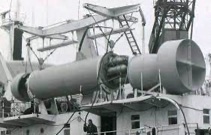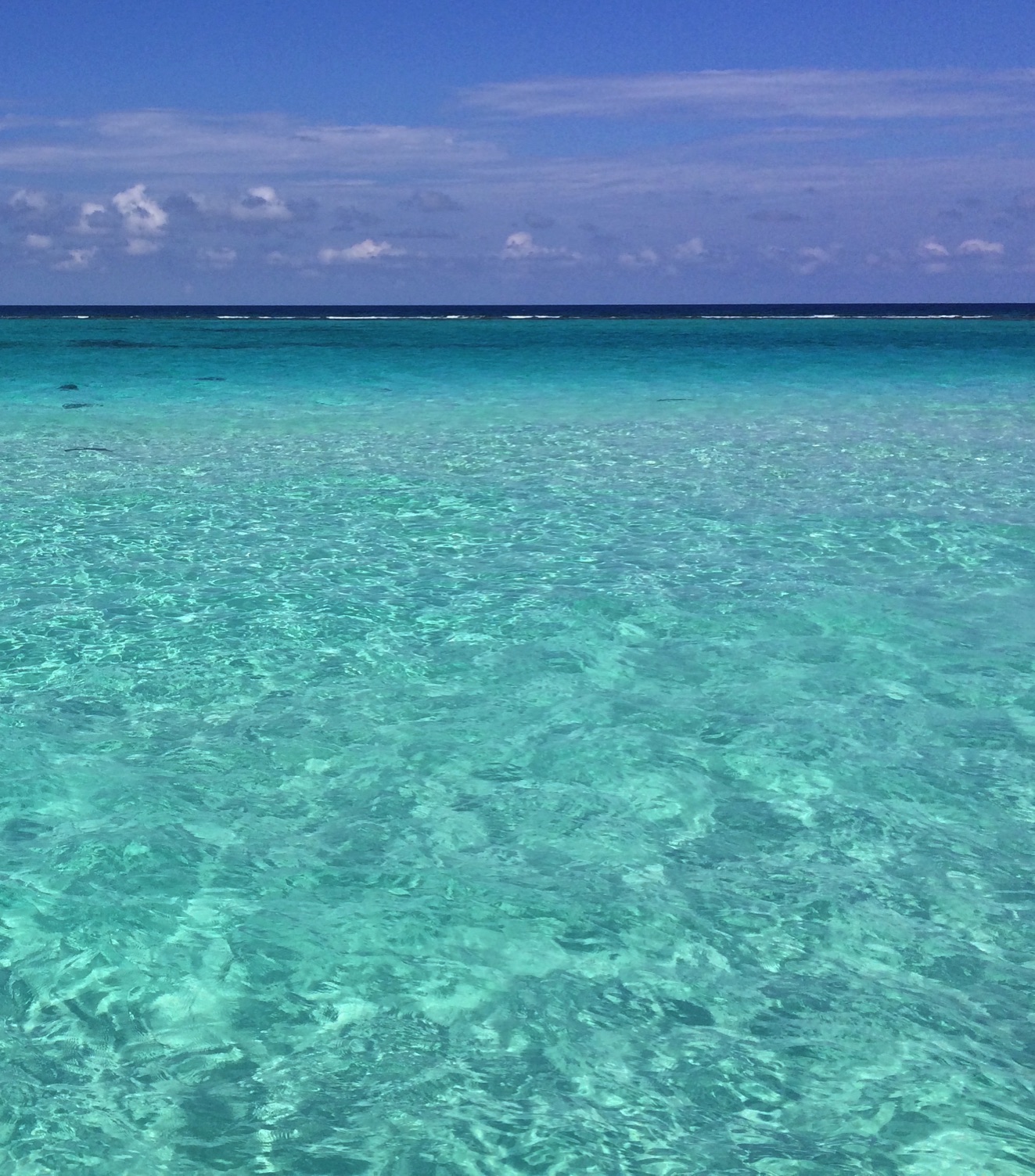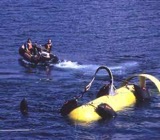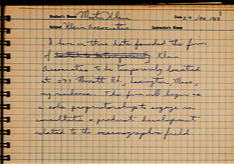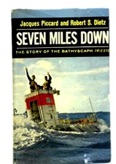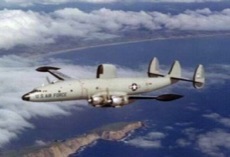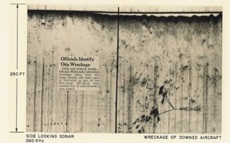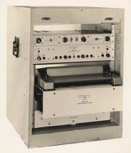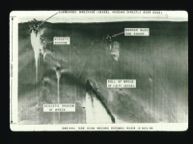MILESTONE CHRONOLOGY 1961 - 1970
1960 - Dr. Harold Edgerton visits Denmark where he sees the Westinghouse classified military side scan sonar.
-The Bathyscaph Trieste with Jacques Piccard and Lt. Don Walsh aboard, makes the historic 35,797 foot dive in the Marianas Trench January 23, 1960.
-Kelvin-Hughes produces the "Fishermans Asdic."
1961 – Martin Klein, an Electrical Engineering senior at Massachusetts Institute of Technology meets Harold Edgerton and asks “Doc” if he might have anything interesting to work on for a senior thesis. Edgerton puts Klein to work improving his “Mud Penetrator” 12 KC sonar. The “Mud Penetrator” normally points downward toward the sea bottom, but Edgerton and Klein point it sideways to make a crude side scan sonar.
1962 - Martin Klein begins work at Edgerton, Germeshausen & Grier Oceanographic Division at 750 Commonwealth Avenue, Boston next to the original Radio Shack.
1963 - Dr. Harold Edgerton, Edward Curley and John Yules use the 12 KC “Mud Penetrator” pointed sideways to find the Vineyard Lightship in Buzzards Bay, Massachusetts.
-The nuclear submarine USS Thresher (SSN-593) sinks April 10, 1963, during deep-diving tests near Cape Cod killing all 129 crew and shipyard personnel aboard. The search for Thresher in 8400 feet of water is the first deep water search in history. The Bathyscaph Trieste which had made the historic 35,797 foot dive in 1960, was called from San Diego to Boston to assist with the Thresher search. A young engineer at Edgerton, Germeshausen & Grier, Inc., Martin Klein, is assigned to lead a team to design a side scan sonar, sub-bottom sonar and long-baseline navigation system on Trieste.
1964 - C.S. Clay and W. Liang of Columbia University Hudson Laboratories publish a paper "Lateral Echo Sounder - Model CL-1." The design of a narrow beam lateral echo sounder for use on a deep-towed vehicle is given. The transducer consists of ferro-electric ceramic cylinders 2 14 in. x 1 12 in. o.d., 1 14 in. i.d. operated in the first radial resonant mode, about 27 kcps. Eighteen cylinders are cemented together to form a long cylinder and placed in an oil-filled boot. The active element is placed in front of a corner reflector made of lead. The lateral beamwidth is about 3 degrees and the vertical beamwidth is 20 degrees. The remote driving electronic circuits, amplifier, etc., and the printed circuit board layouts are given. The instrument transmits a 1-msec duration pulse with a peak power of about 100 w. The results of field tests are shown and indicate that the single-sided range with this power is about 2500 ft. A maximum peak power of 500 w may be delivered with a higher voltage supply.
- Martin Klein and John Yules tests a special towfish in Boston Harbor with right and left pointing 12 KC transducers. The test is successful and they track a small triplane target 2000 feet or more.
-Martin Klein with John Yules, Earl Van Reenan and Don Smith bring the 12 Kc side scan pinger and a new graphic recorder designed by Ed Curley to the Tarrytown Yacht Club on the Hudson River near the Tappan-Zee Bridge. The job was to locate small cables for A.T.&T. With the flat, featureless bottom the cable showed up perfectly.
1965 - Attempts were made to obtain background information between geology of the sea bottom and records made with a side-looking sonar system on tidal flats in Minas Basin, Nova Scotia. The equipment consisted of a side-looking sonar system built at HUDSON LABORATORIES by FRED COLE, Associate Electronic Engineer, based on an earlier Clay-Liang system.
-Work begins at the National Institute of Oceanography on GLORIA (Geological Long-Range Inclined Asdic) begoines in 1965 with sea trials in 1969 and the first scientific papers appearing in 1970. The technical development was led by Stuart Rusby. The system uses chirp technology to enhance signals.
1966 - E.G.&G. announces new single channel side scan sonar system. (https://mitmuseum.mit.edu/collections/object/2014.028.0016.01?filters%5B0%5D%5Bfield%5D=namedCollection&filters%5B0%5D%5Bvalue%5D=Martin%20Klein%20Collection&page=3&resultIndex=25)
-Martin Klein and Robert Henderson bring the new E.G.&G. side scan sonar to give a demonstration on the Potomac River. They make clear shipwreck images.
-The new E.G.&G. Side Scan Sonar images a "Stinger" used for pipe laying. The struts on the stinger can be clearly seen.
– Dr. Harold Edgerton and Martin Klein use Edgerton's 12 KC pinger sideways to locate the sunken tugboat “Jane S. Walton” in about 30 feet of water in Boston Harbor.
-Scripps Intitution of Oceanography annonces a highly complex, electronic, sea-floor mapping instrument FISH (Fully Instrumented Submersible Housing) under the lead design of Dr. Carl Lowenstein.
-A single channel E.G.&G., Inc. 260 kC Side Scan Sonar is used to find the wreckage of a Otis DC-121-H off the coast of Nantucket. This is believed to be the first find of an aircraft wreckage with side scan sonar.
-Martin Klein of E.G.&. G., Inc. travels to the Panama City Mine Defense Laboratory with Robert Henderson and Murray Bubar to demonstrate the new E.G.&G. Side Scan Sonar. Klein is told about the MDL military side scan sonars with higher frequencies and fixed mechanical focus. Klein proposes a new side scan sonar where each of the transducer elements has a variable delay line so that the transducer could be electronically focused in time for a given range. Not knowing how to accomplish this with the electronics of the day, he does not file for an invention.
Edgerton, Germeshausen & Grier, Inc. announces a new subsidiary, E.G.&G. International, Inc. to assume the manufacturing, marketing and field operations for all the company's oceanographic-geophysical products. (https://mitmuseum.mit.edu/collections/object/2014.028.0016.01?filters%5B0%5D%5Bfield%5D=namedCollection&filters%5B0%5D%5Bvalue%5D=Martin%20Klein%20Collection&page=3&resultIndex=25)
1967 - At a June convention of the Marine Technology Society in San Diego, Martin Klein with E.G.&G. introduces the first commercial dual-channel towed side scan sonar system.
- Edgerton used Klein's sonar to help Alexander McKee find Henry VIII's Mary Rose.
-Klein used the sonar to help archaeologist George Bass find a 2000 year old ship off the coast of Turkey.
-Edward P. Curley leaves E.G. & G., Inc. to found EPC Labs. His graphic recorders are later used in many side scan sonar systems.
1968 - In a small rented cottage in Lexington, Massachusetts, Martin Klein founds Klein Associates. The following year the company is incorporated and moves to Salem, New Hampshire.
-Martin Klein and Harold Edgerton publish a paper “Sonar-a modern technique for ocean exploration” in IEEE Spectrum.
1969 - With assistance from Donald Krotser the side scan sonar data is displayed for the first time on a Hewlett-Packard variable-persistance storage oscilloscope.
-George M. Walsh of Raytheon Company receives the first open patent , 3,484,737, "Acoustic Mapping Apparatus" for a hull-mounted side-looking synthetic-aperture-sonar.
-The Gifft line of Depth Recorders and Sonar Transceiver-Programmers is sold to Dillingham Corporation's Hydro Products Division.
- Klein and Kim Byrd introduce the new MK-300 Side Scan Sonar system at the Marine Technology Society Convention in Miami Beach, Florida.
-Klein Associates sold its first production sonar unit, a Klein MK-300, serial number 1, to the University of Pennsylvania, to be used by Dr. George Bass to search for ancient shipwrecks in the Aegean and Mediterranean Seas.
-Klein Associates, Inc. becomes one of the first commercial users of DuPont Kevlar® (originally called “Fiber B”) for the strength member in Klein lightweight towing cable.
-A Klein Side Scan Sonar was used to assist in the clearance of the Suez Canal which had been closed in 1967.
-Side Scan Sonar is carried aboard the French bathyscaphe "Archimede."
1970 - Professor Deryk Chesterman, founder of the Marine Geophysics Unit in the School of Physics at Bath University held the first (and only) Side Scan Sonar Seminar. Two of the speakers were Nigel Kelland and Martin Klein.
-Martin Klein brings a Klein MK-300 Side Scan Sonar system to Loch Ness for an expedition with the Academy of Applied Science of Cambridge, Massachusetts. In one experiment the sonar was tethered on a tripod near the shore with the sonar looking out in the water column. A number of large moving targets were observed. The sonar scans in the Loch revealed some interesting indentations in the steep terrain wall (possible caves?)
-Sonardyne is started in the United Kingdom by John Partridge
- Dr. David Switzer, the Maine Maritime Academy, and MIT found the American Revolutionary War privateer Defence during Klein side scan sonar survey fieldwork in Penobscot Bay, Maine. From 1975-1980, the Institute of Nautical Archaeology, the Maine Maritime Academy, and the Maine State Museum studied and excavated the Defence shipwreck.
